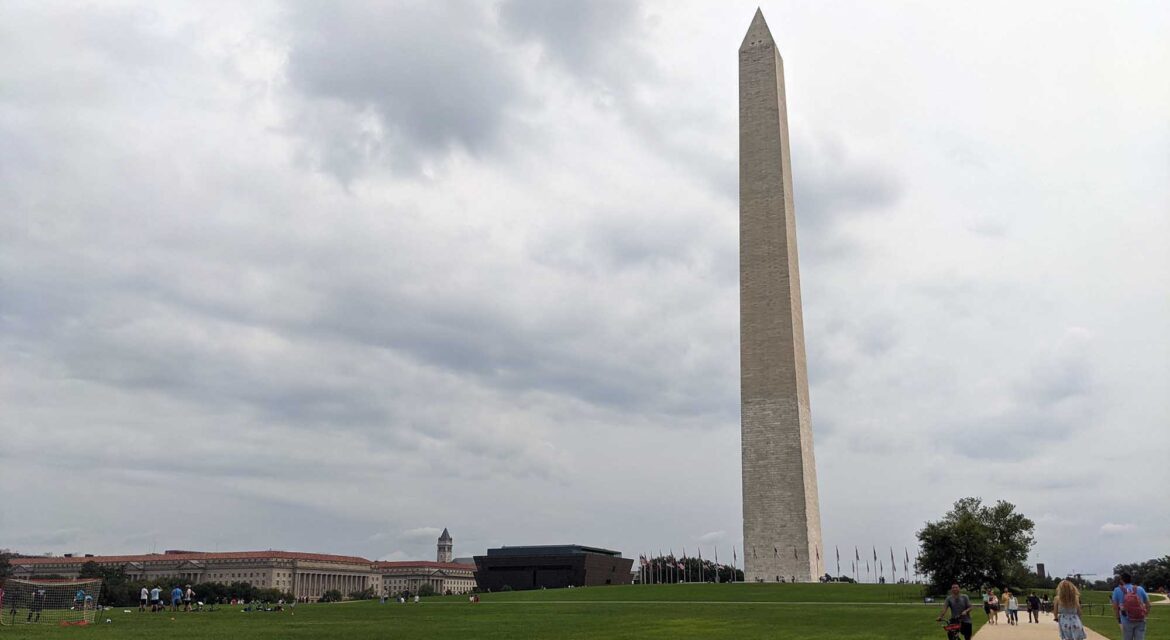 Shaped like an Egyptian obelisk, the Washington Monument is the tallest structure in Washington, D.C. but has come to define the city and nation in ways that are far beyond physical. Created as a tribute to the leadership of George Washington, the incredible scale and scope of the landmark has changed the skyline of the city ever since it was completed. However, the connection it has to the spirit and history of the nation has allowed it to become symbolic of the United States itself to attract audiences from around the country and across the world.
Shaped like an Egyptian obelisk, the Washington Monument is the tallest structure in Washington, D.C. but has come to define the city and nation in ways that are far beyond physical. Created as a tribute to the leadership of George Washington, the incredible scale and scope of the landmark has changed the skyline of the city ever since it was completed. However, the connection it has to the spirit and history of the nation has allowed it to become symbolic of the United States itself to attract audiences from around the country and across the world.

The Tallest Building in the World
 Mentioned as “first in war, first in peace and first in the hearts of his countrymen,” George Washington has been hailed as the father of the United States of America. The push to create a monument in his honor began during his lifetime but he personally scrapped those plans as President. His death in 1799 saw a new effort to create a different type of memorial dedicated to him but the politics of the day prevented it from becoming a reality.
Mentioned as “first in war, first in peace and first in the hearts of his countrymen,” George Washington has been hailed as the father of the United States of America. The push to create a monument in his honor began during his lifetime but he personally scrapped those plans as President. His death in 1799 saw a new effort to create a different type of memorial dedicated to him but the politics of the day prevented it from becoming a reality.
In 1833 the Washington National Monument Society was formed to produce an appropriate memorial to the first president. The group organized a design competition and eventually named architect Robert Mills as the winner for his plan that included a 600-foot-tall obelisk with a temple at the base. The cornerstone for the monument was laid in 1848 but delays and financial issues led to temple portion of it being abandoned. In 1854, with the structure at about 150 feet high, funds ran low and work on the monument was halted.
In 1876, President Ulysses Grant authorized federal funding to finish the monument and work resumed in 1879. Because of the delay, it was impossible to quarry stone of the same shade, which is why the color of the upper two-thirds of the landmark is different from that of the lower third. Dedicated by President Chester Arthur in 1885 and opened to the public in 1888, it was the tallest building in the world for five years.
The 555-foot obelisk made of marble, granite, and bluestone gneiss literally towers over Washington, D.C. However, the physical influence is secondary to the impact it has made to the culture and economy of the entire region and country.
Tours, Events, Products and More
 Numerous guides and hosts can arrange tours of the Washington Monument. The site is free and open to the public, but guests need to get tickets in order to tour the monument and see the breathtaking views from the top of it. Visitors can see nearly 25 miles into the horizon in every direction.
Numerous guides and hosts can arrange tours of the Washington Monument. The site is free and open to the public, but guests need to get tickets in order to tour the monument and see the breathtaking views from the top of it. Visitors can see nearly 25 miles into the horizon in every direction.
As the central element of the National Mall, the Washington Monument has helped to define many of the historic events that have taken place in the area. These include the Longest Walk and the Million Man March as well as annual events like Christmas Tree lightings. Organized and impromptu events continue to take place at and around the Washington Monument in a way that could never happen without the presence of the landmark.
The imposing nature of the Washington Monument has impacted how it is positioned as part of countless pieces of merchandise for sale throughout the city. Businesses and organizations use the image of the Washington Monument to allow audiences to connect with them while maps and guides all highlight and use the monument as a means of identity that resonates with both residents and visitors.
Surrounded at the bottom by fifty American flags that symbolize the current fifty states, the entire monument honors and memorializes the contributions of George Washington to the United States but it has come to represent something much more.

A Sense of Grandeur and National Pride
 While the Washington Monument is no longer the tallest building in the world, it still holds the title of world’s tallest stone structure and obelisk. That physical legacy is secondary to the one that has enabled visitors to connect with a sense of the grandeur and national pride that the Washington Monument would represent at any size, highlighting the many different ways landmarks can influence audiences across the eras.
While the Washington Monument is no longer the tallest building in the world, it still holds the title of world’s tallest stone structure and obelisk. That physical legacy is secondary to the one that has enabled visitors to connect with a sense of the grandeur and national pride that the Washington Monument would represent at any size, highlighting the many different ways landmarks can influence audiences across the eras.


